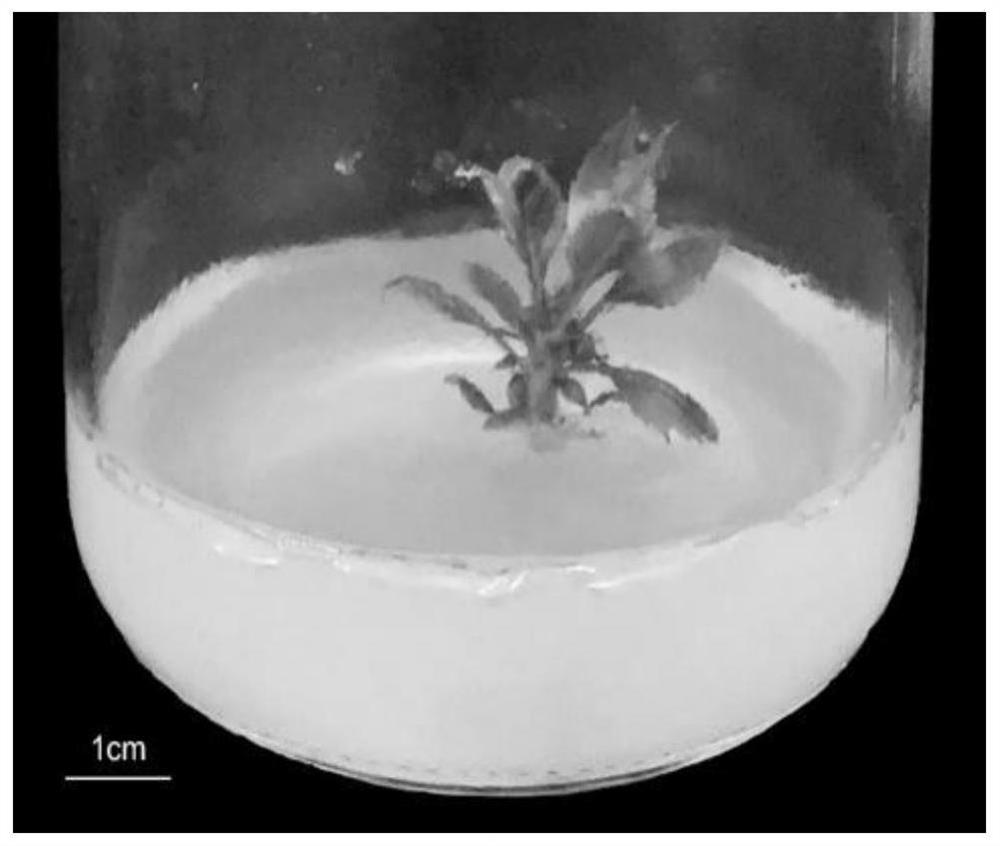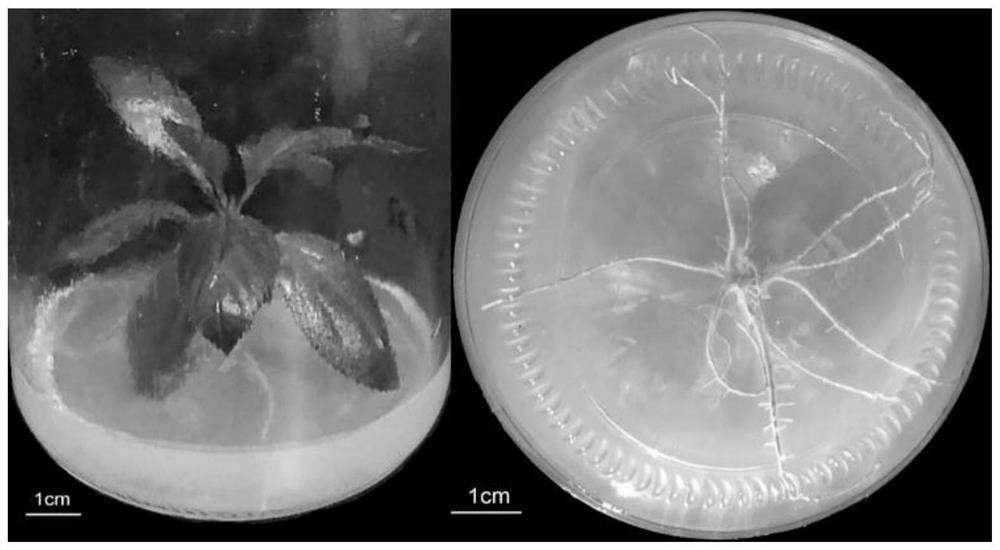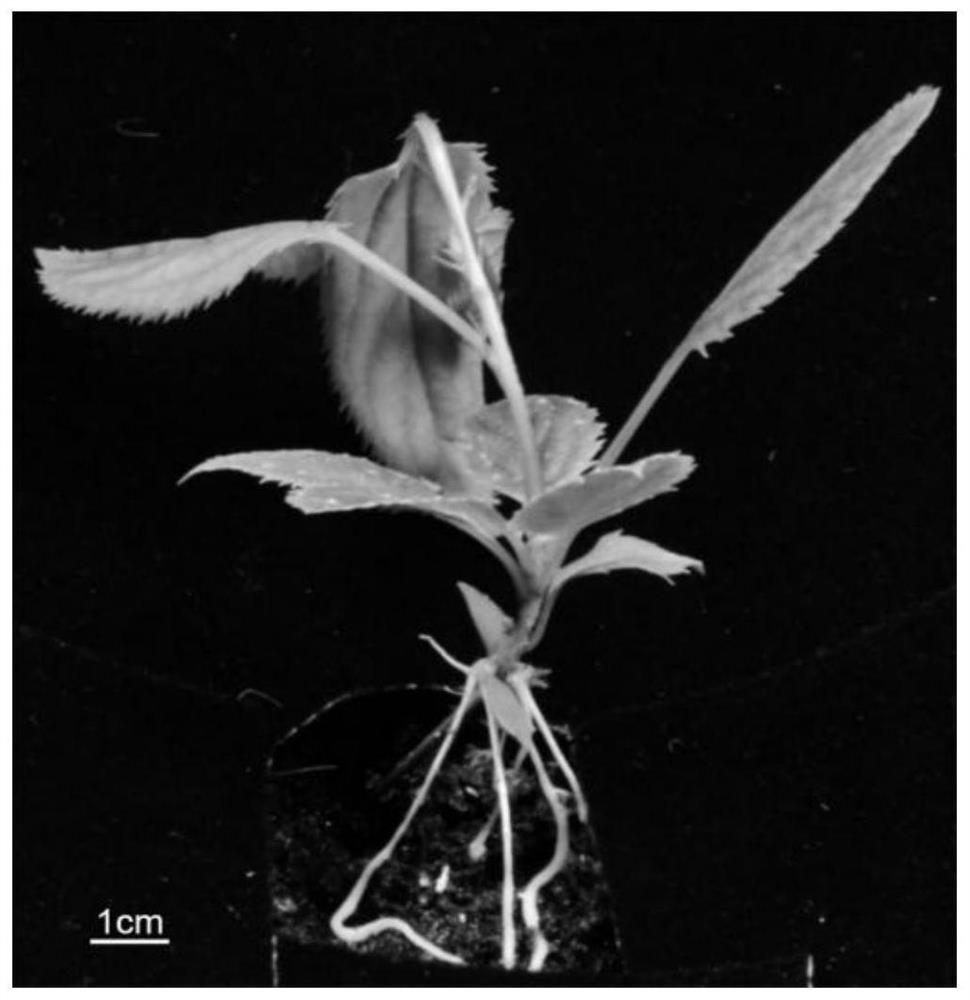A method for constructing transgenic plants mediated by Agrobacterium rhizogenes
A technology of Agrobacterium rhizogenes and transgenic plants, which is applied in the field of plant genetic engineering, can solve problems such as long cycle times, and achieve the effects of simple equipment, no need for redifferentiation, and broad development and application prospects
- Summary
- Abstract
- Description
- Claims
- Application Information
AI Technical Summary
Problems solved by technology
Method used
Image
Examples
Embodiment 1
[0068] Example 1 Induction of eGFP gene-transferred apple hairy roots
[0069] (1) Cultivation of aseptic apple seedlings: the aseptic seedlings of the apple variety Gala are provided by the cross-innovation platform of the School of Forestry, Beijing Forestry University. / L sucrose+8g / L agar, pH=5.8, after growing for 10 days at 22~24°C in the subculture medium (such as figure 1 Shown), transfer to MS+0.5mg / L IBA+30g / L sucrose+8g / L agar, pH=5.8 rooting medium, obtain the apple Gala aseptic seedling of rooting after 40 days (such as figure 2 shown).
[0070] (2) Preparation of the transgenic infection liquid: the 35S-eGFP-pROK2 vector was constructed using the Seamless Assembly Cloning Kit of Zhongmei Taihe Company. The constructed vector was transformed into competent cells of Agrobacterium rhizogenes K599 by heat shock method; the positive clone colony was picked, and firstly mixed with 5ml YEP+20mg / L Rif+50mg / LKana liquid medium at 28°C and 180rpm in a shaker. Shake ove...
Embodiment 2
[0078] Example 2 Effects of Different Agrobacterium rhizogenes on the Induction of Apple Gala Hairy Roots
[0079] Table 1 Effects of different Agrobacterium rhizogenes on the induction of hairy roots of apple Gala
[0080]
[0081] Select aseptic seedlings of apple Gala with consistent growth for subculture and rooting. Three kinds of Agrobacterium rhizogenes MSU440, C58C1 and K599 were amplified to OD with YEP+20mg / L Rif liquid medium at 28°C and 180rpm in a shaker 600 =6.0, make the infection bacteria solution. According to the method shown in Example 1, the apple Gala tissue culture seedlings through subculture rooting were injected into the stem, and then the induction of apple Gala hairy roots was observed.
[0082]As shown in Table 1, different Agrobacterium rhizogenes were used to inject the stems of apple Gala. When injected with MSU440, the induction rate of hairy roots was 10%, and when injected with C58C1, the induction rate of hairy roots was 10%. , when K59...
Embodiment 3
[0083] Effect of different concentrations of embodiment 3 Agrobacterium rhizogenes on the induction of apple Gala hairy roots
[0084] Table 2 Effects of different concentrations of Agrobacterium rhizogenes on the induction of apple Gala hairy roots
[0085]
[0086] Select aseptic seedlings of apple Gala with consistent growth for subculture and rooting. Three copies of Agrobacterium rhizogenes K599 were amplified to OD in a shaker at 28°C and 180rpm with YEP+20mg / L Rif liquid medium 600 = 0.2, OD 600 = 0.4, OD 600 =0.6 to make the infection bacteria liquid. According to the method shown in Example 1, the apple Gala tissue culture plantlets through subculture rooting were injected into the stem, and 40 days after the callus was born, the induction status of apple hairy roots was observed.
[0087] As shown in Table 2, apple stems were injected with different concentrations of Agrobacterium rhizogenes, when OD 600 = 0.4, the induction rate of hairy root was the highest...
PUM
 Login to View More
Login to View More Abstract
Description
Claims
Application Information
 Login to View More
Login to View More - R&D
- Intellectual Property
- Life Sciences
- Materials
- Tech Scout
- Unparalleled Data Quality
- Higher Quality Content
- 60% Fewer Hallucinations
Browse by: Latest US Patents, China's latest patents, Technical Efficacy Thesaurus, Application Domain, Technology Topic, Popular Technical Reports.
© 2025 PatSnap. All rights reserved.Legal|Privacy policy|Modern Slavery Act Transparency Statement|Sitemap|About US| Contact US: help@patsnap.com



